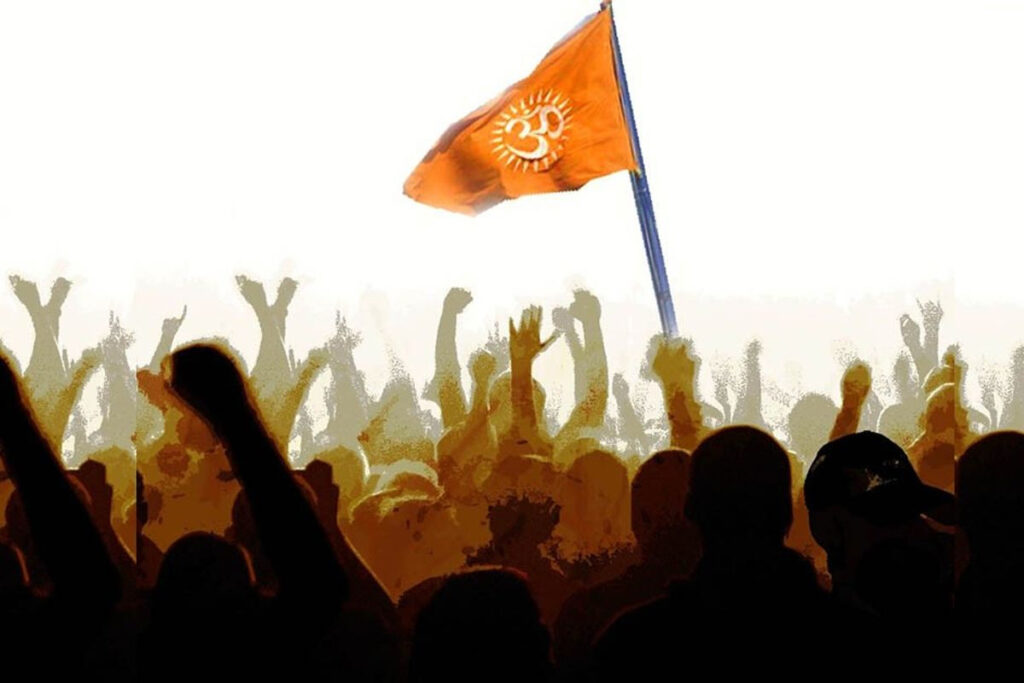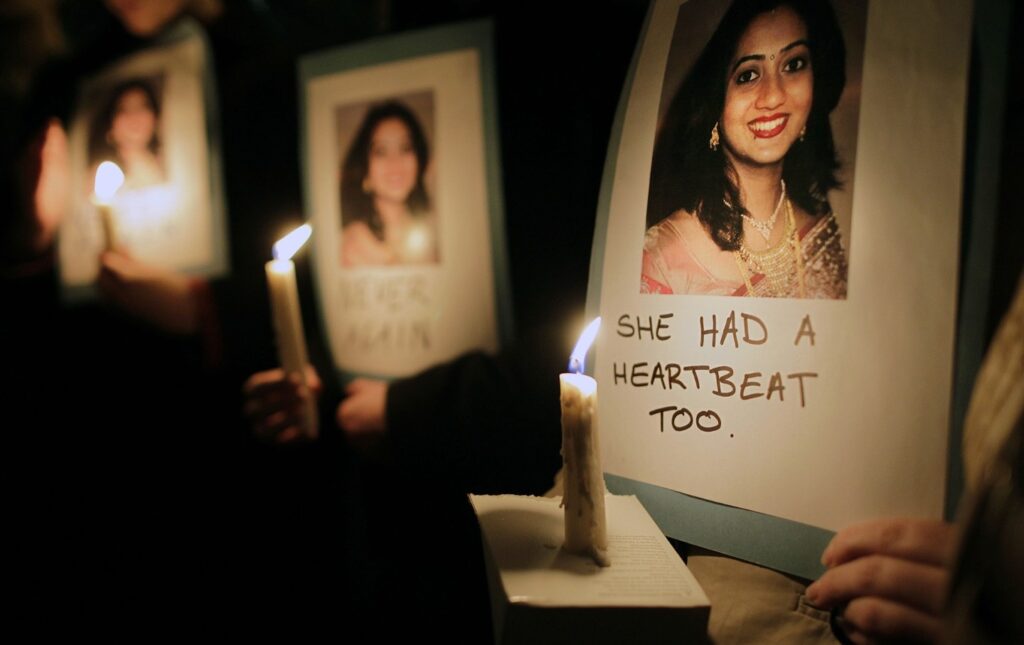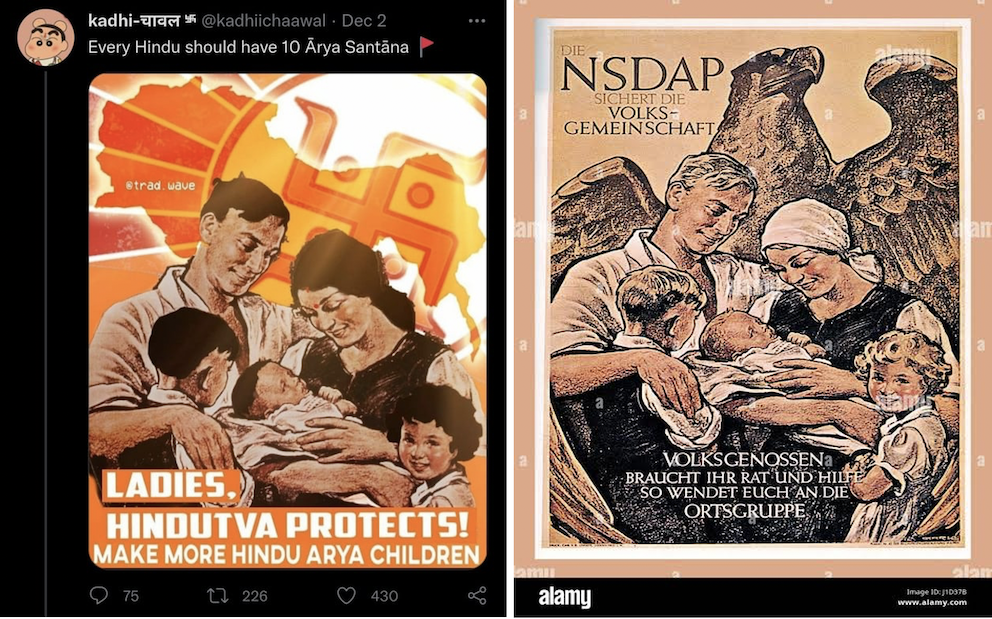Ironic Progress: The Hindu Right’s Expansion of Abortion Access
Abortion as a tool to curate caste-privileged, Hindu families

(Image: Painting of Hindu nationalists marching. Source: Recordnepal.com)
“I’m neither Catholic nor Irish…”
In 2012, Savita Halappanavar pleaded with staff at University Hospital in Galway, Ireland to perform an abortion to complete her miscarriage. They refused, and she died from sepsis a week later. Although Savita’s spouse, Praveen Halappanavar, insisted, “We are Hindu,” the doctors refused to perform the abortion because it would conflict with their mandate as a Catholic hospital and violate Irish law, prohibiting the termination of a pregnancy unless the pregnant person’s life was in imminent danger. In this case, the hospital staff claimed that since fetal cardiac activity was detected and Halappanavar’s life wasn’t in apparent risk, they could not perform the procedure.
Halappanavar’s sudden death spurred a nationwide movement to establish abortion rights in Ireland, culminating in the passage of a public referendum that guaranteed free, legal abortion through the first 12 weeks of pregnancy for any reason and permitting it after that point in cases of incest or risk to the life of the pregnant person. Today, five years after the passage of this referendum, reproductive activists and doctors say that abortion remains difficult to access in Ireland, particularly after the first 12 weeks. Often, those needing abortion care after 12 weeks are stigmatized, offered little support, and forced to navigate complicated and prohibitive legal hurdles.
News of what happened to Halappanavar also sparked outrage in India, with politicians decrying what they saw as a violation of religious freedom and the “murder” of a Hindu by Catholicism. The incident ignited memories of missionary abuses in India, distracting from the country’s own abortion access restrictions. Indeed, reproductive rights advocates in India who had long sought an expansion of India’s abortion laws, found such outcries ironic.
Since 1971, abortion has been legal in India through the Medical Termination of Pregnancy Act (MTP), which has been amended four times, most recently in 2021 to allow single women to seek abortions and receive care from public or private facilities. Notably, the MTP is a legal exception to section 312 of the Indian Penal Code, enacted by the British colonial government in 1860, which criminalizes “willfully causing a miscarriage.” Rather than conferring rights, however, the MTP prevents prosecution.

(Memorial for Savita Halappanavar. Image source: Associated Press)
Despite cultural and religious mores that stigmatizes abortion, the current Indian government, led by the far-right Hindu nationalist Bharatiya Janata Party (BJP), supported the expansion of abortion rights in 2021. Although this may seem progressive to those of us enmired in the reproductive health politics of the U.S., India did not suddenly become a bastion of women’s rights. Indian abortion laws are still not considered particularly women-friendly by the World Health Organization; the Guttmacher Institute estimates that 56% of abortions in India are “unsafe.” Rather, the BJP’s support for abortion rights in India is rooted in patriarchy, casteism, and nationalist views of the ideal Hindu family. Although touted as a mechanism of population control, for the Hindu Right abortion is a reproductive sculpting tool to shape Indian society through an upper-caste) Hindu lens. Consequently, access to safe abortions for many pregnant people remains limited. The Act, for instance, does not address the structural issues associated with abortion: continued stigma linked to the procedure, lack of access to clinics that perform abortions in rural areas, and caste discrimination in public health facilities (caste-oppressed people are often denied or unable to seek care). Further, while the 2021 update to the MTP ostensibly expands access to abortion for unmarried women, it continues to designate which women can seek abortions. Non-traditional and “undesirable” pregnant women (i.e., widows, divorcees, disabled, and rape and incest victims) now may obtain abortions up to 24 weeks, while single women can do so for “failed birth control” up to 20 weeks.
In effect, the MTP permits abortions for people the rightwing Indian government does not want to reproduce—either because of disability or because certain women (especially widows, divorcees, and single women) fall outside of normative family structures. India’s governing party is now using abortion laws to shape Indian society into their vision of the ideal Hindu nation.
Hindu Positions on Abortion
Hindus around the world hold a range of views on abortion. Classic Hindu scriptures and authorities express varying views on pregnancy and abortion. Some Hindu texts (e.g., Caraka Saṃhitā, Bhāgavata Purāṇa) suggest that the soul enters the fetus at the moment of conception. The Garbha (Womb) Upanishad, however, claims that this process happens in the seventh month of gestation. Theologians have variously claimed that the soul enters the fetus sometime between the third and fifth months of gestation, based on how much of the fetus’s body has formed. Given these scriptural constraints, many Hindus view abortion as an unethical act, but also as an individual decision that impacts one’s own spiritual wellbeing.
This position characterizes U.S. Hindu communities; Hindus in America express strong support (68%) for abortion rights. This support rests on three points: 1) Most Hindus believe one should not commit violence against a fetus, but only when it has become “ensouled”—about which, we have seen, there is little consensus; 2) U.S. Hindus typically identify as socially progressive (the majority are Democrats) and support abortion access as a political position; 3) Belief in the concept of karma (action, result), which holds Hindus individually responsible for their choices—while many Hindus may view getting an abortion as against their dharma (ethical code), they regard the consequences of such actions as impacting only those making the choice and therefore, little matter for law. This may explain why many Hindus vote for abortion-friendly policies while holding anti-abortion views.
In India, poll numbers are more mixed. A 2020 survey suggests that support for abortion hovered around 38%, while a more recent study places it at 59%. It appears that both religious belief and cultural practices influence views on abortion. Preference for sons within Hindu communities has made sex-selective abortion a major issue, which is still prevalent in India and, to a lesser degree, in Hindu diasporic communities.
Even though canonical scriptures forbid it, the Hindu preference for sons, which patriarchal values and Vedic texts support, helps explain broad support for abortion-friendly policies in both the U.S. and India. While most Hindus, Muslims, Sikhs, and Jains in India see sex-selective abortion as somewhat or completely unacceptable, a Pew India survey found that “a substantial minority of Indians (40%) say it is completely acceptable or somewhat acceptable ‘to get a checkup using modern methods to balance the number of girls and boys in the family.’”
Caste, Patriarchy and the MTP
Despite being legal and free in India, access to safe abortions remains difficult for many because of a mix of reasons related to caste, region, and patriarchal cultural norms that can create dangerous conditions for pregnant people. Between 2015 and 2021, the period in which the BJP has been in power, stillbirths, abortions, and miscarriages increased, while live births slightly decreased. Notably, India has more than half the world’s stillbirths. Earlier versions of the MTP permitted abortion only under certain circumstances (risk to the life of the mother, rape, incest, fetal anomaly, divorce, and being widowed). The Center for Reproductive Rights explains that even with the revision of the MTP in 2021 to expand abortion access to all women up to 20 weeks (and 24 weeks under specific circumstances), the law still requires doctor certification to receive an abortion, often an insurmountable hurdle for many women in healthcare deserts or those from caste-oppressed or economically marginalized communities. Unsurprisingly, a recent study shows that, “unsafe abortions account for 10-13% of maternal mortality.” These abysmal numbers are related to lack of facilities and supplies, familial restrictions, and the necessity for permission from a spouse or male relative. Although the 2021 update to the MTP removed this requirement, as human rights advocate Sneha Mukherjee points out, “in reality, women are [still] often asked to get permission from their partners or family before getting an abortion.”
The government is also complicit in restricting abortion access, even as it touts greater access to this service. Much like abortion restrictions in several U.S. states—waiting periods, invasive ultrasounds, and multiple doctor’s visits—bureaucratic requirements in India limit access to legal abortion; pregnant people are required to obtain a doctor’s permission to receive an abortion, which curtails women’s access to quick and safe abortions. Additionally, as transgender men have pointed out, there are no legal provisions for non-binary and trans pregnant people to avail themselves of abortion services.
Rural and marginalized communities face financial and cultural impediments to accessing safe abortions. Adivasi (first dwellers), Dalits (“oppressed” communities outside the four Hindu castes, still often derogatorily called “untouchable”) and other caste-oppressed people, sex-workers, and HIV-positive pregnant people are more likely to experience miscarriage and stillbirths, and less likely to have access to safe abortion. Dalit women often face caste and class discrimination from healthcare providers.
In her article on why abortion rights only exist for the caste-privileged, Shreeja Rao tells the story of Babita, who “works as a manual scavenger, an occupation outlawed 10 years ago but continuing nationwide.” Manual scavengers clean sewers by hand, making them physically and spiritually unclean in the eyes of many Hindus. Rao explains that Babita has had three pregnancies and been denied care by government facilities on multiple occasions because of her caste. As Babita says, “Who will treat an untouchable?” Unable to seek an abortion and forced to use private hospitals for reproductive care, Babita borrowed “40,000 rupees” an amount “133 times her monthly income.” The enormous debt burden Babita faces reflects another issue: India’s shortage of gynecologists, obstetricians, and rural healthcare facilities. The lack of resources and caregivers makes reproductive care costly in the private sector and almost impossible to obtain in public hospitals. For Dalit women, this exacerbates an already impossible situation. The limitations on abortion access for marginalized groups should not be read as an accident of bureaucracy or an easily correctable oversight. Rather, it is part of a deliberate attempt by the Indian government to define “family” through a Hindu nationalist lens: family as upper-class, urban, heteronormative, and dominant caste.
Hindutva and the Populist Politics of Family
Hindu perspectives on abortion rights in India are directly related to the Hindutva (Hindu nationalist) project to establish a Hindu state. Hindutva is a far-right political ideology that is only about 100 years old. It was coined by VD Savarkar, who argued that India is a homeland for Hindus and members of “dharmic” faiths (Buddhists, Sikhs, and Jains) alone. Notably, Indian Christians and Muslims (about 17% of the country) are excluded. Current Indian Prime Minister and leader of the BJP Narendra Modi is a permanent member of the paramilitary Hindutva organization Rashtriya Svayamsevak Sangh (RSS). He has shaped the party to have the stated goal of establishing India as a democratic ethnic Hindu state.
Nearly every Modi government policy decision is made with the overarching vision of establishing a Hindu nationalist state. For example, the Indian government has sought to regulate or restrict interreligious marriage by stoking fear of a “love jihad,” accusing Muslim men of systematically tricking caste-privileged Hindu girls into eloping simply to convert them to Islam. Hindu nationalists claim their views are rooted in so-called Vedic scientific principles that they have promoted as modern science. During the COVID-19 pandemic, the Indian government did not “cede the ground of expertise solely to epidemiologists or medical experts” and instead engaged Vedic scientific and medical claims “as science and medicine.” This framing led to the denigration of Muslims as responsible for COVID-19 spread and the proliferation of the derogatory label the “Muslim virus.”
Like other ethnonationalist ideologies, such as Nazism, Fascism, and white supremacy, Hindutva policy positions are rooted in a vision of the traditional nuclear family and Brahmanical Hindu values, such as the preference for male children. Hindutva ideologues even idolize the Nazis. M.S. Golwalkar, who led the RSS beginning in 1940, wrote, “To keep up the purity of its race and culture, Germany shocked the world by her purging of the country of the Semitic races—the Jews. Race pride at its highest has been manifested here…a good lesson for us in Hindustan to learn and profit by.” In fact, early Hindutva propaganda images mimic 1930s Nazi posters. Golwalkar all but tells us how to read the image below—as an ethnocentric reproductive roadmap to make India into a Hindu rashtra (ethno-state). We should understand the Hindutva vision for abortion access as something like this: aborting caste-privileged Hindu babies is bad, while terminating the pregnancies of non-Hindus (read: Muslims) is good for population control. Likewise, while abortion rights should be legal, they should be discouraged among married Hindu women to uphold this stance—a position predicated on the false notion that Muslim populations are growing while Hindus are declining.

(The image on the right shows a Hindutva poster with a man, a woman, and three children. The image on the left is a 1930’s Nazi propaganda poster with a similar rendering of a nuclear family.)
The invocation of the “traditional family” in both posters shows how nationalist populist movements rely on traditional cultural messaging to maintain power. We also see how such depictions purposefully link maternity and reproduction to the ethnonationalist project. Specifically, the image speaks to what Banu Subramaniam describes as a contradiction between Hindutva rhetoric describing India as “female land” and policies that force women into “three possible roles: heroic mother, chaste wife, or celibate warrior.” Since poor, single, caste-oppressed, pregnant people seeking abortions don’t fit this mold, the expansion of abortion rights to single women is about ensuring that procreation furthers the aim of building a Hindu nationalist state that reproduces the cisgender, heteronormative, Brahmanical patriarchy of Hindu majoritarianism.
Case in point: in 2018, the Indian Supreme Court struck down a colonial-era law outlawing “homosexual sex.” The Indian government supported the ruling but advised the court not to alter personal laws that would recognize same-sex marriage. In 2022, the Court expanded the idea of “family” to decree that “same-sex parents, single parents and blended families…[would receive] equal treatment.” In this case, and in a current case before the Indian Supreme Court considering legalizing same-sex marriage, the Indian government has staunchly opposed legally recognizing same-sex partnerships, arguing that “same-sex marriage is not compatible with the concept of an ‘Indian family unit,’ which it said consists of ‘a husband, a wife, and children which necessarily presuppose a biological man as a ‘husband’, a biological woman as a ‘wife’ and the children born out of the union between the two—who are reared by the biological man as father and the biological woman as mother.” It is this definition of family that the Hindutva government wishes to codify in the judicial record. Furthermore, “Indian family unit” is ostensibly a dog-whistle to the Hindu majority in India, while also appealing to the largely socially conservative Muslim and Christian communities, and to Jains and Sikhs. The government’s opposition to marriage equality and its expansion of the MTP should not be read as contradictory actions. Rather, both positions seek to legally recognize the traditionalist image of family seen in the Hindutva propaganda poster.
The Fight over “Family”
The expansion of abortion access in India continues the Hindutva project by seeking to define “family” in heteronormative and traditionalist ways. Explicitly defining “family” in terms of “biological males” and “biological females” underscores the militant Hindutva view that India is a nation of and for caste-privileged Hindus alone.
Legal abortion without widespread access allows caste-privileged Hindus to shape their families to suit orthodox Brahmanical prescripts (read: ensure one child is male). Although sex-selective abortion remains illegal in India, along with procedures that determine the sex of the fetus, preference for sons remains prevalent; many private doctors will provide these services for a fee. This is, perhaps, along with a lack of literacy on reproductive and abortion care, why we see more abortions among urban Indian women than in rural communities. In effect, the Hindu right sees safe abortion as a useful tool to curate caste-privileged families and a rare, inaccessible luxury for those seen as undesirable. While those in rural, economically depressed, and caste-oppressed communities continue to seek abortions, these procedures are often “unsafe” and result in health complications and fatalities.
Ultimately, the commitment to individual choice and a continued preference for sons governs how Hindus in India feel about abortion rights. It also explains why we shouldn’t see India’s expansion of abortion rights as particularly progressive. Rather, the Modi government seized this opportunity to codify a Hindutva-inspired definition of family that recognizes the heteronormative family unit as a founding element of India.
Abortion care has been recognized as a fundamental right by the World Health Organization. To support such rights, India must move towards rights-centered reproductive healthcare that increases access in underserved areas and restructures the MTP to protect and promote safe abortions for all pregnant persons. And following recent Indian Supreme Court rulings, the Indian government must recognize what much of the Indian polity has already embraced – inclusive and varied iterations of family as valid expressions of Indian identity.
Dheepa Sundaram is an Assistant Professor of Religious Studies at the University of Denver. She is a scholar of digital Hindu publics and writes about religious nationalism, online hate politics, yoga, and ritual.